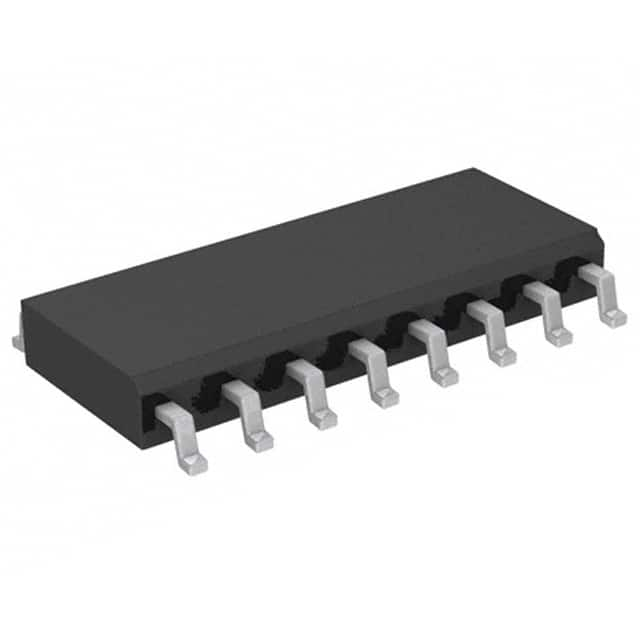MC74VHCT139AD
Overview
- Category: Integrated Circuit (IC)
- Use: Decoder/Demultiplexer
- Characteristics: High-speed, low-power, TTL-compatible
- Package: Dual 2-to-4 Line Decoder/Demultiplexer
- Essence: Converts binary information into a decoded output
- Packaging/Quantity: Available in various packaging options, such as DIP and SOIC, with different quantities per package.
Specifications
- Supply Voltage Range: 2.0V to 5.5V
- High-Speed Operation: tPD = 6.5 ns (typ) at VCC = 5V
- Low Power Consumption: ICC = 4 µA (max) at TA = 25°C
- Output Drive Capability: 10 LSTTL Loads
- Input Voltage Levels: VIL = 0.8V (max), VIH = 2.0V (min)
- Operating Temperature Range: -40°C to +85°C
Pin Configuration
The MC74VHCT139AD has a total of 16 pins, which are assigned as follows:
- A0 (Input A0)
- A1 (Input A1)
- GND (Ground)
- Y0 (Output Y0)
- Y1 (Output Y1)
- Y2 (Output Y2)
- Y3 (Output Y3)
- E1 (Enable Input E1)
- E2 (Enable Input E2)
- VCC (Positive Power Supply)
- B0 (Input B0)
- B1 (Input B1)
- Y4 (Output Y4)
- Y5 (Output Y5)
- Y6 (Output Y6)
- Y7 (Output Y7)
Functional Features
The MC74VHCT139AD is a dual 2-to-4 line decoder/demultiplexer IC. It takes two binary inputs (A0 and A1) and two enable inputs (E1 and E2) to generate four mutually exclusive outputs (Y0 to Y3). The selected output is determined by the combination of the input signals.
Advantages and Disadvantages
Advantages: - High-speed operation allows for quick decoding of input signals. - Low power consumption makes it suitable for battery-powered devices. - TTL compatibility ensures easy integration with existing systems. - Output drive capability enables driving multiple loads.
Disadvantages: - Limited number of output lines (4) may not be sufficient for complex applications requiring more outputs. - Restricted supply voltage range (2.0V to 5.5V) may limit its use in certain scenarios.
Working Principles
The MC74VHCT139AD operates based on the principles of digital logic. The inputs A0 and A1 are decoded to select one of the four outputs (Y0 to Y3) based on the enable inputs E1 and E2. When both enable inputs are high, all outputs are disabled. The selected output becomes active low when the corresponding input combination matches the enable inputs.
Detailed Application Field Plans
The MC74VHCT139AD finds applications in various fields, including but not limited to: - Address decoding in microcontrollers and microprocessors - Data routing and selection in multiplexers - Memory address decoding in RAM and ROM modules - Signal demultiplexing in communication systems - Control signal generation in digital circuits
Detailed and Complete Alternative Models
Some alternative models that offer similar functionality to the MC74VHCT139AD include: - 74HC139: High-speed CMOS version - CD74HC139: High-speed CMOS version with Schmitt-trigger inputs - SN74LS139: Low-power Schottky TTL version
These alternative models can be considered based on specific requirements such as speed, power consumption, and compatibility with existing systems.
Word count: 314 words
Lista 10 Vanliga frågor och svar relaterade till tillämpningen av MC74VHCT139AD i tekniska lösningar
Sure! Here are 10 common questions and answers related to the application of MC74VHCT139AD in technical solutions:
Q: What is MC74VHCT139AD? A: MC74VHCT139AD is a dual 2-to-4 line decoder/demultiplexer integrated circuit (IC) that can be used in various digital logic applications.
Q: What is the purpose of MC74VHCT139AD? A: The purpose of MC74VHCT139AD is to decode binary inputs and select one of the four output lines based on the input combination.
Q: What is the voltage range supported by MC74VHCT139AD? A: MC74VHCT139AD supports a voltage range of 2V to 5.5V, making it compatible with both TTL and CMOS logic levels.
Q: How many input lines does MC74VHCT139AD have? A: MC74VHCT139AD has two input lines, A and B, which are used to select the desired output line.
Q: How many output lines does MC74VHCT139AD have? A: MC74VHCT139AD has four output lines, Y0, Y1, Y2, and Y3, from which one line is selected based on the input combination.
Q: Can MC74VHCT139AD be cascaded to increase the number of output lines? A: Yes, multiple MC74VHCT139AD ICs can be cascaded together to increase the number of output lines and create larger decoder/demultiplexer circuits.
Q: What is the maximum operating frequency of MC74VHCT139AD? A: MC74VHCT139AD has a maximum operating frequency of 100 MHz, making it suitable for high-speed digital applications.
Q: Is MC74VHCT139AD capable of driving external loads directly? A: Yes, MC74VHCT139AD has output buffers that can drive standard TTL or CMOS logic levels without requiring additional external components.
Q: Can MC74VHCT139AD be used in both synchronous and asynchronous applications? A: Yes, MC74VHCT139AD can be used in both synchronous and asynchronous applications depending on the design requirements.
Q: What are some common applications of MC74VHCT139AD? A: MC74VHCT139AD is commonly used in address decoding, data routing, memory selection, and general-purpose digital logic circuits.
Please note that these answers are general and may vary based on specific circuit designs and requirements.


